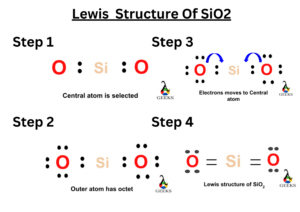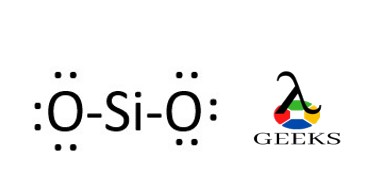Silicon dioxide (SiO2) has a network structure where each silicon (Si) atom, with 4 valence electrons, forms double bonds with two oxygen (O) atoms, each contributing 6 valence electrons. The Lewis structure depicts each Si atom bonded to four O atoms in a tetrahedral arrangement, and each O atom bonded to two Si atoms. This leads to a 3D network of Si-O-Si bonds, with bond angles of approximately 109.5°. The Si=O double bond is due to Si’s ability to expand its octet, accommodating more than 8 electrons. This structure contributes to SiO2’s high melting point and low reactivity.
Key Takeaways
- The Lewis structure of SiO2 shows that silicon (Si) is surrounded by four oxygen (O) atoms, each forming a double bond.
- The Lewis structure of SiO2 is a useful tool for understanding the bonding and electron distribution in the molecule.
- The SiO2 molecule has a linear shape, with the silicon atom in the center and the oxygen atoms arranged symmetrically around it.
- The Lewis structure of SiO2 can help predict the chemical properties and reactivity of the molecule.

Lewis Dot Structure of SiO2
Silicon dioxide (SiO2) is a chemical compound composed of silicon and oxygen atoms. Understanding the Lewis dot structure of SiO2 can provide insights into its electronic configuration, bonding, and electron distribution. Let’s explore each aspect in detail.
Electronic Configuration of Si and O atoms
To understand the Lewis dot structure of SiO2, it is essential to first examine the electronic configuration of silicon (Si) and oxygen (O) atoms.
- Silicon (Si): Si has 14 electrons. Its electronic configuration is 1s2 2s2 2p6 3s2 3p2. In the Lewis dot structure, Si is represented by the symbol “Si” with four dots around it, indicating the valence electrons.
- Oxygen (O): O has 8 electrons. Its electronic configuration is 1s2 2s2 2p4. In the Lewis dot structure, O is represented by the symbol “O” with six dots around it, indicating the valence electrons.
Bonding in SiO2
SiO2 is a covalent compound, meaning it forms bonds through the sharing of electrons between Si and O atoms. Each Si atom forms bonds with two O atoms, and each O atom forms bonds with one Si atom. This results in a network of interconnected Si-O bonds.
Formation of Si-O Bonds
The formation of Si-O bonds in SiO2 involves the sharing of electrons between Si and O atoms. Each Si atom contributes two electrons, while each O atom contributes six electrons. This sharing of electrons allows both Si and O atoms to achieve a stable electron configuration.
Electron Distribution in SiO2 Molecule
In the SiO2 molecule, each Si atom is bonded to two O atoms, and each O atom is bonded to one Si atom. This arrangement results in a tetrahedral structure, where each Si atom is at the center of a tetrahedron formed by four O atoms.
The electron distribution in the SiO2 molecule can be visualized using a Lewis dot structure. In this structure, the Si atom is represented by the symbol “Si” with four dots around it, indicating the valence electrons. Each O atom is represented by the symbol “O” with six dots around it.
Lewis Structure of SiO2
The Lewis dot structure of SiO2 can be represented as follows:
| Si | O | O |
|---|---|---|
In this structure, each Si atom is surrounded by four dots, representing its four valence electrons. Each O atom is surrounded by six dots, representing its six valence electrons.
The Lewis dot structure of SiO2 provides a visual representation of the electron distribution in the molecule and helps in understanding its chemical properties and behavior.
In conclusion, the Lewis dot structure of SiO2 reveals the electronic configuration of Si and O atoms, the bonding between them, and the electron distribution in the molecule. Understanding these aspects is crucial for comprehending the properties and behavior of SiO2.
Molecular Geometry and Hybridization of SiO2
Silicon dioxide (SiO2) is a chemical compound composed of silicon and oxygen atoms. Understanding the molecular geometry and hybridization of SiO2 is crucial in comprehending its properties and behavior. In this section, we will explore the VSEPR theory and molecular geometry of SiO2, as well as the hybridization involved in its structure.
VSEPR Theory and Molecular Geometry
The VSEPR (Valence Shell Electron Pair Repulsion) theory is a model used to predict the molecular geometry of a molecule based on the repulsion between electron pairs around the central atom. According to this theory, electron pairs, whether bonding or non-bonding, repel each other and tend to position themselves as far apart as possible to minimize repulsion.
In the case of SiO2, the central silicon atom is surrounded by two oxygen atoms. Each oxygen atom forms a double bond with silicon, resulting in a linear molecular geometry. The VSEPR theory predicts this linear arrangement because the two oxygen atoms and their electron pairs repel each other, causing the molecule to stretch out in a straight line.
Hybridization of SiO2

Hybridization is the process of combining atomic orbitals to form new hybrid orbitals that are suitable for bonding. In SiO2, the silicon atom undergoes sp hybridization, which involves the mixing of one s orbital and one p orbital. This hybridization allows the silicon atom to form two sigma bonds with the oxygen atoms.
The sp hybrid orbitals of silicon are oriented in a linear arrangement, aligning with the linear molecular geometry of SiO2. This hybridization enables the silicon atom to achieve a stable electronic configuration and form strong bonds with the oxygen atoms.
To summarize, the molecular geometry of SiO2 is linear, and the silicon atom undergoes sp hybridization to form sigma bonds with the oxygen atoms. This arrangement and hybridization contribute to the unique properties and behavior of silicon dioxide.
| Molecular Geometry | Hybridization |
|---|---|
| Linear | sp |
Understanding the molecular geometry and hybridization of SiO2 provides insights into its structure and properties. This knowledge is essential in various fields, including chemistry, materials science, and engineering, where silicon dioxide plays a significant role. By studying the arrangement of atoms and the bonding involved, scientists can better comprehend the behavior and reactivity of SiO2 in different applications.
Polarity of SiO2 Molecule

Silicon dioxide (SiO2) is a chemical compound composed of silicon and oxygen atoms. Understanding the polarity of the SiO2 molecule is crucial in comprehending its chemical properties and interactions with other substances. In this section, we will explore how the dipole moment, symmetrical arrangement of Si-O bonds, and the nonpolar nature of SiO2 contribute to its overall polarity.
Determining the Dipole Moment of SiO2
The dipole moment of a molecule is a measure of its polarity. It indicates the separation of positive and negative charges within the molecule. To determine the dipole moment of SiO2, we need to examine the electronegativity difference between silicon and oxygen.
Oxygen is more electronegative than silicon, meaning it has a greater affinity for electrons. In the SiO2 molecule, oxygen atoms tend to attract the shared electrons towards themselves, resulting in a partial negative charge (δ-) on the oxygen atoms and a partial positive charge (δ+) on the silicon atom.
This unequal distribution of charge creates a dipole moment within the SiO2 molecule. However, the dipole moments of individual Si-O bonds cancel each other out due to the symmetrical arrangement of the bonds, resulting in a nonpolar molecule overall.
Symmetrical Arrangement of Si-O Bonds
In the SiO2 molecule, each silicon atom is bonded to two oxygen atoms through double bonds. The arrangement of these bonds around the silicon atom is symmetrical, resembling a V-shaped structure. This symmetrical arrangement ensures that the dipole moments of the Si-O bonds cancel each other out.
The cancellation of dipole moments occurs because the dipole moments of the two Si-O bonds are equal in magnitude but opposite in direction. As a result, the overall dipole moment of the SiO2 molecule becomes zero, making it a nonpolar molecule.
Nonpolar Nature of SiO2
Due to the symmetrical arrangement of the Si-O bonds and the cancellation of dipole moments, the SiO2 molecule is nonpolar. This means that there is no significant separation of positive and negative charges within the molecule.
The nonpolar nature of SiO2 has important implications for its physical and chemical properties. For example, nonpolar molecules tend to have lower boiling and melting points compared to polar molecules. Additionally, nonpolar molecules are less soluble in polar solvents but may dissolve in nonpolar solvents.
In summary, the SiO2 molecule exhibits a nonpolar nature due to the symmetrical arrangement of its Si-O bonds, which results in the cancellation of dipole moments. Understanding the polarity of SiO2 is essential in comprehending its behavior in various chemical reactions and its interactions with other substances.
Frequently Asked Questions
Lewis Structure of SiO2
The Lewis structure of SiO2, also known as silicon dioxide, is a diagram that represents the arrangement of atoms and valence electrons in the molecule. It helps us understand the bonding and geometry of the compound. Let’s explore some common questions related to the Lewis structure of SiO2.
Q: How do you draw the Lewis structure of SiO2?
To draw the Lewis structure of SiO2, we first need to determine the total number of valence electrons in the molecule. Silicon (Si) is in Group 4A of the periodic table and has 4 valence electrons, while oxygen (O) is in Group 6A and has 6 valence electrons. Since there are two oxygen atoms in SiO2, we have a total of 16 valence electrons (4 from Si + 6 from each O).
Next, we arrange the atoms in the structure. Silicon is the central atom, surrounded by two oxygen atoms. Each oxygen atom forms a double bond with silicon, sharing two pairs of electrons. This leaves 12 valence electrons remaining.
We then distribute the remaining electrons around the atoms, ensuring that each atom has an octet (except for hydrogen, which only needs 2 electrons). In SiO2, we place the remaining 12 electrons as lone pairs on the oxygen atoms, giving each oxygen atom a total of 8 electrons and silicon a total of 8 electrons.
The final Lewis structure of SiO2 shows silicon in the center, connected to two oxygen atoms by double bonds, and each oxygen atom having two lone pairs of electrons.
Q: What is the molecular geometry of SiO2?
The molecular geometry of SiO2 is linear. In the Lewis structure, we can see that the two oxygen atoms are bonded to the central silicon atom, and there are no lone pairs on the central atom. This arrangement results in a linear shape, with a bond angle of 180 degrees.
Valence Electrons in SiO2
Understanding the concept of valence electrons is crucial when studying the properties and behavior of chemical compounds. Let’s delve into some questions related to the valence electrons in SiO2.
Q: How many valence electrons does SiO2 have?
SiO2, or silicon dioxide, consists of one silicon atom (Si) and two oxygen atoms (O). Silicon is in Group 4A of the periodic table, meaning it has 4 valence electrons. Oxygen is in Group 6A, so each oxygen atom has 6 valence electrons. Since there are two oxygen atoms in SiO2, the total number of valence electrons is 16 (4 from Si + 6 from each O).
Q: Why are valence electrons important in SiO2?
Valence electrons play a crucial role in determining the chemical properties and reactivity of a compound. In SiO2, the valence electrons are involved in the formation of chemical bonds between silicon and oxygen atoms. The sharing of electrons between atoms allows them to achieve a stable electron configuration, typically with an octet of electrons in the outermost energy level.
Understanding the number and arrangement of valence electrons helps us predict the type of bonding (ionic or covalent) and the overall structure of SiO2. It also provides insights into the compound‘s physical and chemical properties.
Dipole Moment of SiO2
The dipole moment is a measure of the polarity of a molecule. Let’s explore some questions related to the dipole moment of SiO2.
Q: Does SiO2 have a dipole moment?
SiO2 is a linear molecule, with oxygen atoms on either side of the central silicon atom. Since the oxygen atoms are identical and have the same electronegativity, the bond dipoles cancel each other out. As a result, SiO2 has no net dipole moment.
In other words, the molecule is nonpolar because the electron distribution is symmetrical. The oxygen-silicon-oxygen bond angles are 180 degrees, and the electronegativity difference between silicon and oxygen is not significant enough to create a dipole moment.
Q: Why is the dipole moment of SiO2 important?
Understanding the dipole moment of SiO2 is essential in predicting its physical properties, such as solubility and boiling point. Nonpolar molecules, like SiO2, tend to have weaker intermolecular forces and lower boiling points compared to polar molecules.
Additionally, the dipole moment affects the molecule’s behavior in an electric field. Nonpolar molecules are not attracted to electric fields, while polar molecules experience a force and tend to align themselves with the field.
By considering the dipole moment of SiO2, we can gain insights into its chemical behavior and interactions with other molecules.
In conclusion, understanding the Lewis structure, valence electrons, and dipole moment of SiO2 provides a foundation for comprehending its properties and behavior. These concepts help us analyze the bonding, geometry, and polarity of SiO2, contributing to our understanding of this important compound.
Conclusion
In conclusion, understanding the Lewis structure of SiO2 is crucial for comprehending its chemical properties and behavior. By visualizing the arrangement of atoms and electrons in a molecule, we can gain insights into its bonding and reactivity. The Lewis structure of SiO2 reveals that silicon (Si) forms a central atom, surrounded by two oxygen (O) atoms. The structure consists of two double bonds between Si and O, resulting in a stable and symmetrical molecule. The Lewis structure also helps us understand the hybridization of Si and O atoms, which affects their bonding and geometry. Overall, SiO2 Lewis structure drawings provide a valuable tool for studying and predicting the behavior of this important compound in various chemical processes.
Frequently Asked Questions
Q: What is the Lewis structure of CO2?
A: The Lewis structure of CO2 consists of a central carbon atom bonded to two oxygen atoms. The carbon atom is double-bonded to each oxygen atom, and each oxygen atom has two lone pairs of electrons.
Q: How do you draw the dot and cross diagram for SO2?
A: To draw the dot and cross diagram for SO2, start by placing the sulfur atom in the center. Then, connect the sulfur atom to two oxygen atoms using double bonds. Finally, add lone pairs of electrons around each oxygen atom to satisfy the octet rule.
Q: Why are Lewis dot structures important?
A: Lewis dot structures are important because they help us understand the bonding and electron distribution in molecules. They provide a visual representation of how atoms are connected and how electrons are shared or transferred.
Q: What is the Lewis structure of SiO?
A: The Lewis structure of SiO is not possible because silicon (Si) does not typically form a stable compound with oxygen (O) in a 1:1 ratio. Silicon dioxide (SiO2) is a more common compound involving silicon and oxygen.
Q: How do you draw the Lewis structure for SiO2?
A: To draw the Lewis structure for SiO2 (silicon dioxide), start by placing the silicon atom in the center. Then, connect each oxygen atom to the silicon atom using double bonds. Finally, add lone pairs of electrons around each oxygen atom to satisfy the octet rule.
Q: What is the structure and bonding in SiO2?
A: SiO2 (silicon dioxide) has a three-dimensional network structure. Each silicon atom is bonded to four oxygen atoms through covalent bonds, forming a tetrahedral arrangement. The strong covalent bonds between silicon and oxygen give SiO2 its high melting point and hardness.
Q: How do you draw the dot and cross diagram for O2?
A: The dot and cross diagram for O2 (oxygen gas) consists of two oxygen atoms, each with six valence electrons. Draw two oxygen atoms side by side and connect them with a double bond. Each oxygen atom should have two lone pairs of electrons.
Q: What is the Lewis structure of SiO2?
A: The Lewis structure of SiO2 (silicon dioxide) consists of a central silicon atom bonded to two oxygen atoms. Each oxygen atom is double-bonded to the silicon atom, and the silicon atom has no lone pairs of electrons.
Q: What is the dot and cross structure of SO2?
A: The dot and cross structure of SO2 (sulfur dioxide) consists of a central sulfur atom bonded to two oxygen atoms. The sulfur atom is double-bonded to one oxygen atom and has a lone pair of electrons. The other oxygen atom is single-bonded to the sulfur atom and has two lone pairs of electrons.
Q: What is the Lewis diagram for SO2?
A: The Lewis diagram for SO2 (sulfur dioxide) consists of a central sulfur atom bonded to two oxygen atoms. The sulfur atom is double-bonded to one oxygen atom and has a lone pair of electrons. The other oxygen atom is single-bonded to the sulfur atom and has two lone pairs of electrons.
Also Read:






